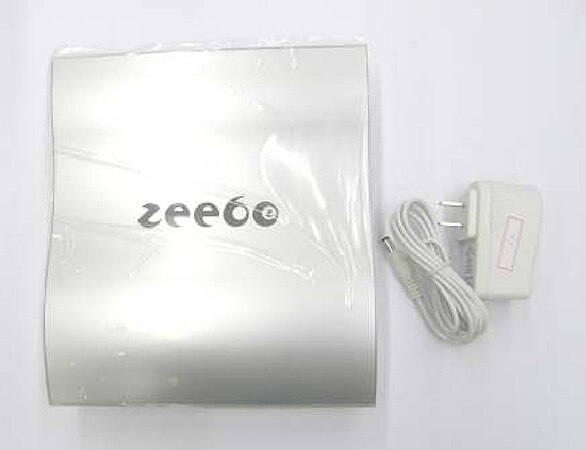History of video games/Platforms/Zeebo
-
A Zeebo console.
History edit
Development edit
Zeebo was developed by the company TecToy,[1] a company which had been involved in distributing the Sega Genesis in Brazil.
Prototypes consisted of a mobile phone motherboard with some extra support hardware.[2]
Launch edit
Zeebo was set to be launched in Brazil in 2009, with the console costing $249 USD with four included games and a free game download, and games costing at most $15 USD.[3] By September 2009 the Zeebo was available only in Rio De Janeiro, and cost 499 BRL, though it saw a price drop to BRL 399 that month.[4] Later in 2009 Zeebo was released in Mexico.[5]
Discontinuation edit
Zeebo was discontinued in 2011.[6]
Technology edit
The Zeebo uses a Qualcomm chipset[7] with a 32 bit CPU based on the ARM11 architecture clocked at 528MHz.[8]
The Zeebo is also equipped with a QDSP-5 and a Adreno 130 GPU capable of rendering 4 million triangles a second.[8]
The Zeebo has 160 megabytes of RAM, and 128 megabytes of VRAM.[8]
The Zeebo runs BREW software (Binary Runtime Environment for Wireless) and can be connected to the internet over a 3G wireless connection.[3][9] The Zeebo became one of the earliest home game consoles to feature a wireless mobile internet connection as a standard feature.
User avatars called Zeeboids could be created, similar to Mii avatars on the Wii.[9]
Notable games edit
The Zeeboo had a library of 55 games, none of which could be obtained after official servers shut down in September 30th, 2011.[9] As a result it is possible that some Zeebo titles are lost media.
The Zeebo had ports of Resident Evil 4, FIFA, and Tekken titles.[10][5]
2009 edit
Zeebo Extreme edit
Read more about Zeebo Extreme on Wikipedia.
2010 edit
Un Juego de Huevos edit
Zeebo exclusive title.
Read more about Un Juego de Huevos on Wikipedia.
External Resources edit
- Video Game Kraken Zeebo page.
- Video Game Console Library - Zeebo page.
References edit
- ↑ "Tectoy's Zeebo gaming console to run on 3G network in Brazil" (in en). Engadget. https://www.engadget.com/2008-11-12-tectoys-zeebo-gaming-console-to-run-on-3g-network-in-brazil.html. Retrieved 25 October 2020.
- ↑ Jordan, Jon. "Why the G1 Google phone might end up the most popular game console ever" (in en). www.pocketgamer.com. https://www.pocketgamer.com/features/why-the-g1-google-phone-might-end-up-the-most-popular-game-console-ever/.
- ↑ a b Reisinger, Don. "The Zeebo game console: Why it matters". CNET. Retrieved 25 October 2020.
- ↑ Remo, Chris. "Zeebo Console Reduces Price, Expands Game Selection" (in en). www.gamasutra.com. https://www.gamasutra.com/view/news/25440/Zeebo_Console_Reduces_Price_Expands_Game_Selection.php. Retrieved 25 October 2020.
- ↑ a b Orland, Kyle. "Zeebo Raises $17M For Internationally-Focused Game Console" (in en). www.gamasutra.com. https://www.gamasutra.com/view/news/126792/Zeebo_Raises_17M_For_InternationallyFocused_Game_Console.php. Retrieved 25 October 2020.
- ↑ July 2013, Jeff Dunn 15. "Chasing Phantoms - The history of failed consoles" (in en). gamesradar. https://www.gamesradar.com/chasing-phantoms-history-failed-consoles/6/. Retrieved 25 October 2020.
- ↑ "Qualcomm MSM chipset Game Console by Zeebo Inc. Launches". ForbesOnTech. Retrieved 28 October 2020.
- ↑ a b c "Home Page". Video Game Console Library. Retrieved 28 October 2020.
- ↑ a b c "Brazil Of Games: The World's First Digital Only Console, And Why It Failed" (in english). Destructoid. https://www.destructoid.com/--547728.phtml#post. Retrieved 25 October 2020.
- ↑ Sheffield, Brandon. "Mike Yuen on Zeebo's Launch, Potential for Indies" (in en). www.gamasutra.com. https://www.gamasutra.com/view/news/27305/Mike_Yuen_on_Zeebos_Launch_Potential_for_Indies.php. Retrieved 25 October 2020.
